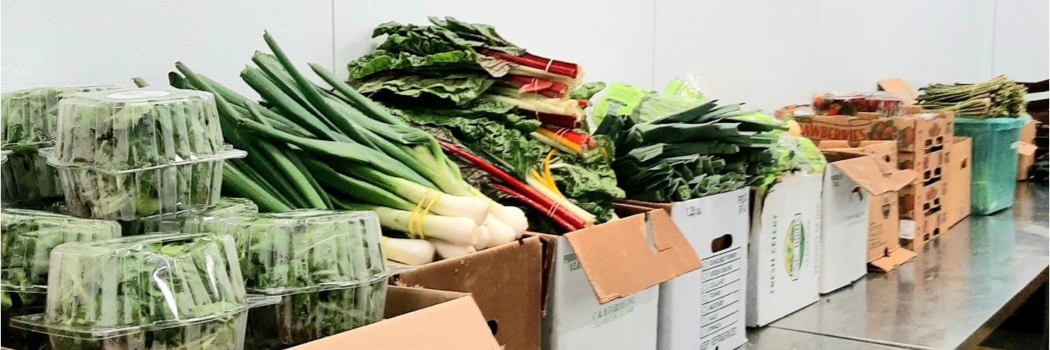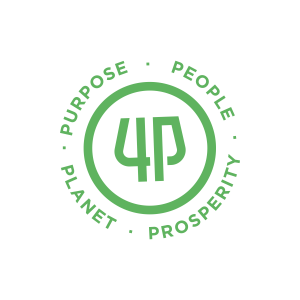Meet the Activator is a regular series designed to highlight the incredible and diverse solution builders activating capital for regeneration across the agriculture and food system.
Company: 4P Foods, PBC
Description of Company:
4P Foods is a Public Benefit Corporation, launched in 2014, with a mission to build a new food system: A system that is Regional, Resilient, Regenerative, and Equitable, as an alternative to our current industrial food system, which is Linear, Fragile, Extractive, and Oppressive. Our North Star keeps us pointed towards a model that can be replicated and scaled in the pursuit of mitigating and ultimately reversing the current trajectory of a warming planet.
To achieve that Mission, 4P Foods operates as a hub-and-spoke distribution company. The company has two (soon to be three) warehouses in the Mid-Atlantic, a fleet of refrigerated trucks, a team of 52 FTEs, and a multi-channel customer base. It buys food from hundreds of small producers, and then sells and distributes that food into our B2C, B2B, and Food-as-Medicine markets. It serves households, grocery stores, universities, public schools, food banks, low-income health clinics, and more with nutrient dense, locally and regionally sourced, hyper-delicious, climate-friendly foods.
Founded in: 2014
Funds Raised: $10.7M raised to date from several sources (see more below)
We caught up with Tom McDougall Founder and CEO of 4P Foods, PBC, a nine year old food distribution company working to build a Regional, Resilient, Regenerative, and Equitable food system. Tom’s been at this for nearly a decade and has some valuable lessons to share about what he’s learned along the way and what exciting things lie ahead.
What prompted you to start 4P Foods?
Tom: I grew up working on a farm in the Hudson Valley. Throughout my childhood and teenage years, that farm failed and was sold off to developers… what was once a 200 acre dairy cattle operation in my backyard is now a golf course. Fast forward a bit, and my first career had me doing a lot of work in China; manufacturing then doing import/export work (which is where I began to learn about distribution). It was during this time that I saw and experienced externalities of our global systems… environmental degradation, human rights abuses in factories… True *costs* not ever captured by the *price* the end user was paying. It had a big impact on me. I joke now describing myself as an environmental and social justice activist stuck inside an entrepreneurs body. In 2014, I launched 4P Foods to try to build a new system, and hopefully play a small role in changing the trajectory our planet is currently on.
By the end of the decade, we are currently projected to surpass the 1.5 degrees Celsius target set by the Paris Climate Agreement, ushering in catastrophic human suffering for tens of millions of people. By the end of this century, when my newborn child turns 77, we will be at or beyond 2 degrees Celsius, at which point critical components of Earth’s systems will have collapsed, social fabrics will have eroded, and billions of sentient beings across every natural ecosystem will have been displaced or perished. The importance of building a new food system goes far beyond a business opportunity – it is a moral and strategic imperative.
“The importance of building a new food system goes far beyond a business opportunity – it is a moral and strategic imperative.”
What problem are you solving for?
Tom: 4P Foods is building the unsexy, very boring, but absolutely necessary plumbing system – the pipes, the pumps, (the infrastructure, the tech) – that is required to enable the connection between the demand for Regenerative food grown within our regional foodsheds and the corresponding supply coming from communities of farmers and ranchers that are willing and able to meet that demand, if only the plumbing existed.
How do you characterize the impact of your work?
Tom: In the 4P’s themselves: Our Purpose is to measure and value our impact on People, Planet, and Prosperity equally. We center rural economies and small farms when thinking about and building a decentralized supply web. We are constantly exploring ways to reduce and eventually eliminate our carbon footprint including electrifying our delivery fleet, and actively participating in the ongoing conversations around how we all define (and measure) Regenerative agriculture. We work with a seemingly endless network of partners to ensure equitable access to the food we distribute for ALL communities, regardless of income, race, or zip code. We do all of this, and more, all while working closely with an investor community that understands the importance – and long-term nature – of building a new system.
4P Foods has raised $10.7 million to date, can you tell us more about who has provided this funding?
Tom: Yes, $10.7M raised to date, inclusive of my personal life savings [not much] to start the company (I don’t recommend this to other Founders!), Expenditure Responsibility Grants, Convertible Notes, a SAFE, CDFI Debt, Venture Debt, a priced Equity Round, revenue share agreements, Foundation/Philanthropic grants, and Local, State, and Federal/USDA Grants. We have what could accurately be described as a “Blended Cap Stack” – something we intend to build upon (and share as a playbook for others) in the near future.
What’s the biggest challenge you have faced on your fundraising journey?
Tom: The lack of True Cost Accounting in our global economic system means that externalities are allowed for and rewarded. When exclusively measuring Financial Capital, without a uniform framework for assigning value to Social and Environmental Capital, social enterprise and social impact investors alike are stuck trying to figure out how to justify the Financial Capital investments that are required to help businesses like ours that are trying to change the world. Being on the front edge of that conversation, that tension, that frontier, has made much of our fundraising work bespoke, and at times, slow and onerous. In other words, the shortcomings of the current financial system, as designed, have been our biggest challenge when it comes to building a new system that might replace the current one.
“…the work of building a new food system – is going to require the simultaneous creation of a new financial system, or at the very least, a different way for the financial system to measure and assign value to returns.”
You mention that you have and will continue to build a “blended capital stack” – can you explain why you chose this option and how it has benefited 4Ps growth?
Tom: We’ve taken the blended cap stack approach before knowing it was an actual approach. In many ways, it’s still new, and there certainly isn’t a clear roadmap for a social enterprise to raise integrated capital. That said, we’ve done it because we recognize our work – the work of building a new food system – is going to require the simultaneous creation of a new financial system, or at the very least, a different way for the financial system to measure and assign value to returns. If this movement plans to save the world through food, measuring and valuing financial returns exclusively is not going to get us where we need to be, and certainly not at the speed with which we need to get there. All that said, to your question, why have we taken this approach? Several reasons, but mostly out of necessity to align our mission with our pursuit of margin. For one thing, our business is heavy on infrastructure, which is not something institutional capital loves to jump into. We also know that our work is going to take decades, not years. Those two things alone make our business model challenging for traditional VC models that have high return and relatively short timeline requirements for their LPs.
Meanwhile, foundations and philanthropic investors appreciate what we’re building from an impact perspective, but they often don’t have the appetite to use their funding for growth capital – things like investing in our technology, growing our team, expanding marketing for the sake of customer acquisition, and so on. Then there’s the debt lenders – our trucks, our warehouses, our inventory. Those are good hard assets that are appropriately funded by debt (and not equity), so that also has a role in our business. Lastly, there’s grants – government grants, state grants, cooperative agreements (sort of like grants), and others that have all helped to catalyze the growth of our business. Combining all of those forms of capital has been tremendously helpful for us because we’ve been able to invest in the critical infrastructure and team required to do this work, while still being laser-focused on growing a profitable business that can scale through replication. While the playbook for raising a blended capital stack may not have existed years ago when we started doing this work, we feel grateful to be playing a role in helping to create a rough draft of one, so that other social enterprises can use and build upon it.
Have you experienced any drawbacks to a blended capital stack?
Tom: There has been no shortage of drawbacks to this approach – the phrase, “building the plane while flying it,” comes to mind. The biggest drawback has been the time – doing what we have done has taken a lot of time, and I imagine it will continue to take time. However, it is time well spent… developing a framework for an expenditure responsibility grant to be paired with an Equity Raise, for example, took nearly a year, but the innovation, collaboration, business implications, and corresponding social impact and business growth of the grant+equity round was profound. Each one of our rounds and investments has taken a lot of bespoke work, which we plan to streamline in our upcoming round. The other major drawback has been the one that I think we all are experiencing and trying to solve for: Everyone knows we need to measure and value social and environmental impacts, but how do we do that? For us, we have the beginning framework for some of those ideas, but we need the rest of the movement to continue pursuing data-driven solutions that can measure ecosystem biodiversity, nutrient density, carbon sequestration, water retention, soil health, rural economic development, wealth transfer, economic mobility, and more. We – the collective “we” – are not there yet, but we need to keep moving forward with the intention of building the new framework of the future.
“If you don’t die, you always have a chance for all your dreams to come true!”
What are your next steps as an organization?
Tom: To meet the rapidly growing demand for local, sustainably produced, and equitably sourced food, 4P Foods has fostered relationships with over 200 farmers through the mid-Atlantic. For this to scale, 4P is expanding its relationships with a set of regional grower networks. Each network – including informal grower communities, farmer cooperatives, and more formally structured food hubs – works with a group of farmers to help them get “contract ready.” This includes providing critical technical assistance such as food-safety certification, transitioning to regenerative farming practices, meeting 4P’s packaging standards, and accessing capital to meet demand. Together, these networks are stitched together with technology and infrastructure, resulting in the alternative to industrial, linear, extractive supply chains in the form of regional, regenerative, supply webs.
What’s the most important lesson you have learned on your journey so far?
Tom: As one of my mentors told me along the way, after one of our many near-death experiences as a company: “If you don’t die, you always have a chance for all your dreams to come true!”
Learn more about 4P Foods here.
Would you like your company to be highlighted as an activator in RFSI News? Email us here.

